
The dark web often evokes images of clandestine activities and hidden corners of the internet. However, understanding its structure and function is essential for both cybersecurity professionals and the general public.
The dark web refers to a segment of the internet that isn’t indexed by standard search engines like Google or Bing. Unlike the surface web, which is accessible to anyone with an internet connection, the dark web requires specialized software to access. This hidden realm is part of the broader deep web, encompassing all unindexed online content, such as private databases and password-protected sites.
Accessing the Dark Web Safely
To explore the dark web, users typically employ anonymizing browsers like Tor (The Onion Router). Tor routes your internet traffic through a series of volunteer-operated servers, encrypting data multiple times to ensure anonymity. This process conceals your IP address, making your online actions difficult to trace.
However, merely using Tor doesn’t guarantee complete safety. To enhance security while accessing the dark web:
- Use a Virtual Private Network (VPN): A VPN adds an extra layer of encryption, masking your IP address even before connecting to the Tor network.
- Keep Software Updated: Regularly update your operating system and security software to protect against vulnerabilities.
- Avoid Downloading Files: Files from the dark web may contain malware. Refrain from downloading or opening unsolicited files.
- Be Cautious with Links: Not all .onion sites are trustworthy. Use reputable directories and avoid clicking on suspicious links.
Benefits of Observing the Dark Web
While the dark web is often associated with illicit activities, monitoring it can offer several advantages:
- Early Threat Detection: By keeping an eye on dark web forums and marketplaces, organizations can identify if their sensitive data has been compromised, allowing for swift remedial action.
- Understanding Cybercriminal Tactics: Observing discussions and trends on the dark web provides insights into emerging cyber threats and attack methodologies.
- Protecting Brand Reputation: Detecting counterfeit products or unauthorized use of a brand’s intellectual property on the dark web enables companies to take corrective measures promptly.
- Compliance and Risk Management: Regular monitoring assists in ensuring compliance with data protection regulations by identifying potential breaches and mitigating risks.
For a more comprehensive understanding of the dark web, including its nuances and implications, consider watching the following video:
!! Note: Accessing the dark web carries inherent risks. Always prioritize your safety and ensure you’re compliant with local laws and regulations.